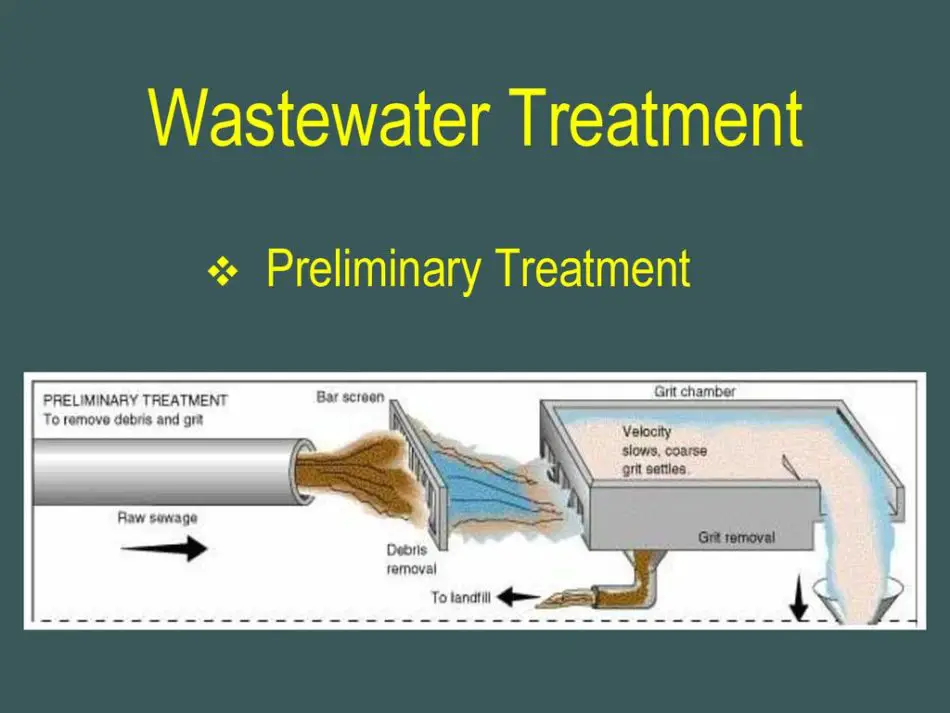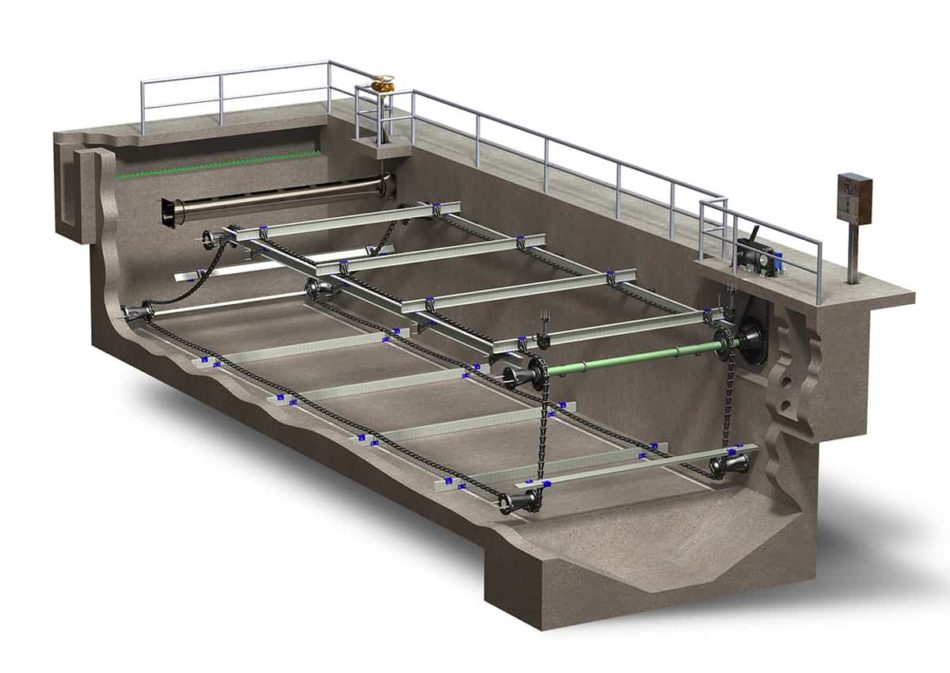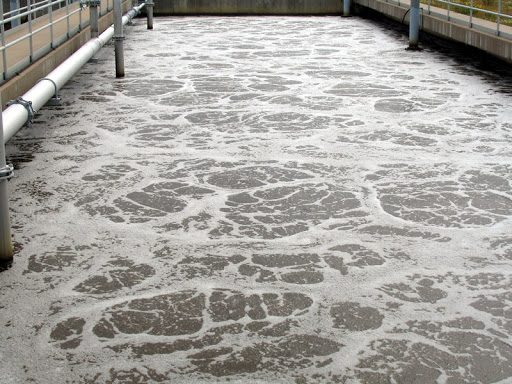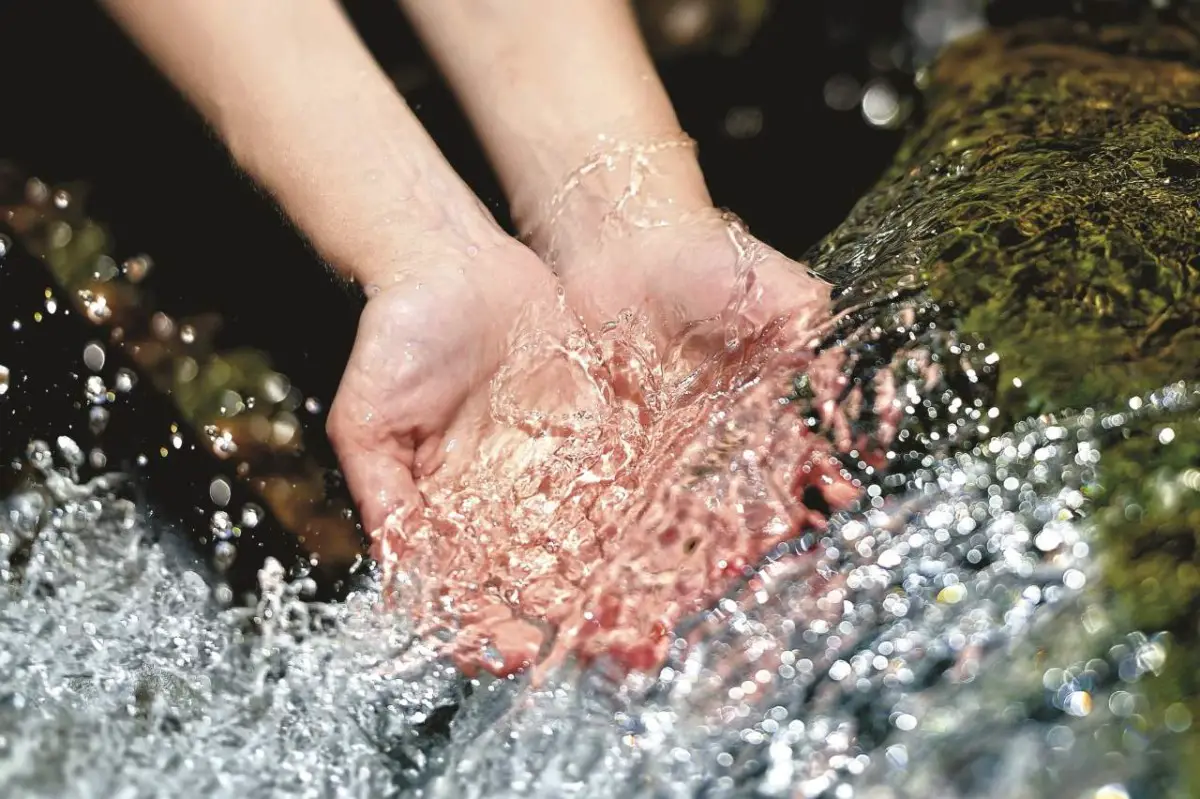Wastewater treatment facilities involve natural, chemical, and physical processes that allow for development and growth. There are three different stages of wastewater treatment, each one working together to remove organic and inorganic loadings that would pollute the receiving streams in our environment. What are the 3 Stages of Wastewater Treatment?
- Primary Stage-separates settable organic solids & inorganic material that won’t degrade
- Secondary Stage-removes suspended & soluble solids converting them to settable solids using Biological Oxidation
- Tertiary Stage-uses chemical & physical treatment to create H2O closer to potable quality
The main objective of Wastewater Treatment is to separate solids from the liquid and then treat both, turning the solids into nonhazardous Bio-solids and water into non-threatening environmentally safe water to add back to the environment where it came from with the intention of using it again.
1. Primary Wastewater Treatment
Stage 1.- Includes Preliminary Treatment located at what is called the Headworks in the Primary Wastewater Treatment part of a plant. It involves the first couple of processes in a Conventional Wastewater Treatment Plant. 
Where inorganic material that won’t degrade in the Biological System is separated from the Wastewater, it’s a treatment process that is a vital part of the process and one that is often overlooked and the least pleasant part of the operation.
Wide Bar Screen-this is often accomplished using a large gapped metal screen, often called a Bar Screen, which is placed in front of the water source intake. Large items are trapped in
Grit Removal-heavy inorganic material has found its way into the miles of sewer lines on its way to the treatment plant. These inert, heavy materials are removed by what’s called a Grit chamber.
Everything from sand, rock, stone, gravel, and inorganic debris end up in this Grit Removal System. This material can be the size of a pebble to a tree trunk or anything that is washed down through the long length of sewer piping. This material has an adverse effect on pumps and machines up ahead in the next stages of treatment.
Most plants use An aerated grit removal system to remove particles by forcing water that has passed through bar screens into a grit chamber, which has air pumped into it. The air causes a spiral of water to flow through the tank, and heavier particles are thrown out of the water’s streamline.
 Eventually, after hitting the wall of the box, the heavier particles settle at the bottom of the tank, while the lighter organic particles are suspended and eventually pass through the tank.
Eventually, after hitting the wall of the box, the heavier particles settle at the bottom of the tank, while the lighter organic particles are suspended and eventually pass through the tank.
The right amount of air is important, so the Grit Box is able to separate the heavier inert objects and keep the flow moving along to the next stage. This Grit Box is normally emptied on a scheduled basis according to flow or will just fill up, eventually taking an important part of the treatment process away from the treatment plant.
- Fine Screening- Another set of Screens is set up to catch and remove more rags and debris that will be smaller and keep the system free of that inorganic material that may clog and interrupt the rest of the system. This is always cleaned and raked, collected, and added to the landfilled material.
- Comminutors- After the manual screening, Comminutors are used in wastewater streams for further protection of rags and debris. Comminutors grind, shred and cut plastics and rags up in small pieces so that they can be separated from the wastewater and won’t affect the next processes they are also used prior to pumps so that protection from blockages is afforded. When solids removal is the preferred practice, the comminutor is installed upstream of the fine screen and offers it protection.
Primary Settling Tank
 After Preliminary Treatment and inorganic material and debris are removed from the wastewater, the next step is to remove the organic solids. The organic solids are materials that can be processed at the treatment facility by separating these solids from the rest of the wastewater we use simple gravity.
After Preliminary Treatment and inorganic material and debris are removed from the wastewater, the next step is to remove the organic solids. The organic solids are materials that can be processed at the treatment facility by separating these solids from the rest of the wastewater we use simple gravity.
Suspended solids that pass through screens and grit chambers are removed from the sewage in sedimentation tanks. These tanks, also called primary clarifiers, provide about two hours of detention time for gravity settling to take place.
In Conventional Wastewater Treatment Plants, the flow from Preliminary Treatment is split into four long tanks that allow the water to slow down to less than 0.5 feet per second. Sedimentation Tanks also come in Circular design At this speed, floatable material will separate from the water to the top, and the heavier settable solid material will sink to the bottom.
The floatable material (also called “scum”) is skimmed off the surface of the water and also sent to the digester.
Primary treatment of wastewater involves the sedimentation of solid waste within the water. This is done after filtering out larger contaminants within the water. Wastewater is passed through several tanks and filters that separate water from contaminants.
The resulting “sludge” is then fed into a digester, in which further processing takes place. This primary batch of sludge contains nearly 50% of suspended solids within the wastewater. Again as you can see, the principle of Wastewater treatment is to separate the solids from the liquid, and the more the operation separates the solids from the liquid, the cleaner the Wastewater becomes.
As you can see in the picture of a Primary Clarifier tank, rakes, or what are called flights, continuously travel across the bottom and top of the clarifier and scrapes the settled sludge to the end of the unit that falls into a Sludge Hopper.
The Flights are bolted to a chain and slowly driven by a motor that moves the settled sludge on the floor of the tank forward to the front Sludge Hopper. The Scum that floats is skimmed off the top of the tanks and collected and mixed with the settled sludge.
Pumps are used to pull the settled “sludge” out of the hopper and send it to Anaerobic Digestor, where Sludge Treatment is performed. After the Primary Settling and the sludge is separated, the Wastewater is sent to Secondary Treatment.
2. Secondary Wastewater Treatment
 Stage 2. – Includes Secondary Treatment using different methods of Biological Oxidation to further purify wastewater. The Conventional Activated Sludge Process is the most popular, using Aeration in a long, but effective process that entails mixing and aerating wastewater in a solution of microorganisms grown in the system that breakdown organic material and separates dissolved solids. This can be accomplished by:
Stage 2. – Includes Secondary Treatment using different methods of Biological Oxidation to further purify wastewater. The Conventional Activated Sludge Process is the most popular, using Aeration in a long, but effective process that entails mixing and aerating wastewater in a solution of microorganisms grown in the system that breakdown organic material and separates dissolved solids. This can be accomplished by:
Aeration-Aeration is a long, but effective process that entails mixing wastewater with a solution of microorganisms. The resulting mixture is then aerated for up to 30 hours at a time to ensure results. It’s more of a Standard to this day than the Oxidation Ponds and Biofiltration.
Biofiltration-This method of secondary treatment of wastewater employs sand filters, contact filters, or trickling filters to ensure that additional sediment is removed from wastewater. Of the three filters, trickling filters may be the most effective for small-batch wastewater treatment.
Oxidation Ponds-Oxidation ponds are typically used in warmer places. In addition, this method utilizes natural bodies of water like lagoons. Wastewater is allowed to pass through this body for a period of time and is then retained for two to three weeks.
Because Aeration is the most typical of the Secondary Methods used today, and 9 out of 10 systems use Aeration Systems for a few different reasons. Space and ease of operation are a few.
We will use this type to talk about. The secondary stage of treatment removes about 85 percent of the organic matter in sewage by making use of the bacteria that are naturally found in it. Increased oxygen encourages the growth of bacteria, which consume and break down complex organic compounds.
The most Standard secondary treatment techniques that are used mostly in North America today are the Conventional Activated Sludge Process. After effluent leaves the sedimentation tank in the primary stage, it flows or is pumped to a Secondary treatment using one or the other of these processes.
Activated Sludge Process
Secondary treatment is part of the Wastewater Treatment process that breaks down organic matter and removes dissolved and colloidal solids. This organic waste material would create a high Oxygen demand on the receiving stream if it were let go into the environment.
Secondary treatment is traditionally applied to the liquid portion of sewage after initial Preliminary and Primary treatment has removed settleable solids and inorganic floating material.
The Activated Sludge Process is performed by aquatic microorganisms in a managed aerobic habitat. Bacteria and protozoa consume biodegradable soluble organic contaminants (e.g. sugars, fats, and organic short-chain carbon molecules from human waste, food waste, soaps, and detergent) while reproducing to form cells of biological solids growing from young to old.
This Sludge is called Activated Sludge. Suspended solids and many organic solids are absorbed or adsorbed by the sludge, while the organic matter is oxidized by the microorganisms using it as a food source.
Mixed in an Aeration Tank, the Activated Microorganisms or (Bugs) need water, oxygen (from the aeration), and food (from the Primary Effluent) to grow and clean the Wastewater further. The Cells in the Microbes will break down, consume and convert Carbon and Nitrogen found in the Primary Effluent and use it as a food source for the Activate Sludge that will grow and get heavier until some of it’s taken out of the system.
This is called Sludge age and is calculated during the operation of the Plant. Dissolved oxygen, or DO, is a measure of how healthy the entire Bio-system is and needs to be checked numerous times a day.
How many Bio-Solids to keep in the system or how many to take out is a process control for keeping the Secondary Treatment healthy and happy. Carbon (food source) and having enough oxygen (needed for cell growth) are important to keep the Bugs in the system doing their job.
Besides cleaning the Wastewater, the Bugs will also convert Ammonia to Nitrates, then the Nitrates are converted to Nitrogen Gas, which leaves the water as gas and enter the atmosphere. Using the age of the Activated Sludge, the Operator can make changes to dictate what is needed to create a healthier Secondary Treatment Process.
Secondary Treatment of Wastewater
Secondary treated sewage has been around for a while and is needed to meet the standards EPA sets for the quality of the plant’s effluent. Less than 30 mg/l, BOD, and less than 30 mg/l suspended solids are typical results. BOD or Biochemical Oxegen Demand is the amount of oxygen consumed by bacteria and other microorganisms while they decompose organic matter under aerobic conditions.
This test is used to show the Organic strength of the wastewater and is an indicator of the overall efficiency of the treatment process. BOD of Influent-BOD after Primary Treatment-BOD at Effluent discharge. This will give a percent removal and show how efficient the overall process of the Wastewater Plant is.
Weekly averages may be up to 50 percent higher. A sewage treatment plant providing both primary and secondary treatment is expected to remove at least 85 percent of the BOD and suspended solids from domestic sewage. NPDES, which stands for the National Pollutant Discharge Elimination System, permits establishing discharge limits and conditions for discharges from municipal wastewater treatment facilities to waters of the United States.
After the Biomass and the incoming flow from Primary Treatment are mixed in the Aeration Tanks for a certain period of time, the Wastewater enters what is called the Final Clarification Tanks. These tanks are Circular or Rectangular, but all work the same way.
They act similarly to the Primary Settling Tanks. But, these tanks separate Activated Sludge instead of Primary Sludge from the treated Wastewater. The Tanks function much like the Primary tank function using Flights on the bottom floor that move the settled activated sludge towards the front hoppers of the tanks.
The Hoppers are pumped out to a Return Sludge line that will bring Activated Sludge back to the head of the Aeration Tanks, where the Microbes will get another chance to consume and break down more waste entering and mixing from the same point as the Primary effluent.
Some of these Bugs or microorganisms will be taken out of the system or what is called Wasted from the system. This controls the age of the Activated Sludge and how active they are or how much they reproduced, an important process control key to the operation and efficiency of the treatment.
What is left is clear water completely separated from the solids, but all Activated Sludge Wastewater Treatment Plants have one more treatment. The vast majority of wastewater treatment plants around the world provide secondary treatment through Conventional activated sludge processes.
Some plants have Tertiary treatment processes that use an additional filtration process to further improve water quality. The resulting effluent typically requires a disinfection step before being discharged back into the environment. Here is a great video that explains how the Biological Process and how “Bugs” work to make Wastewater cleaner than ever.
Wastewater Sludge Treatment
The by-product of Wastewater or Sewage Treatment is called Bio-Solids. These are the Solids that are removed in the primary treatment and secondary systems. Sewage sludge, semisolid, or slurry residual material that is produced as a by-product of the wastewater treatment processes still needs more treatment and is considered volatile.

Most large Wastewater Treatment Plants use 2 Stage Anaerobic Digestion to treat the solids removed from the Primary and Secondary Treatment facilities.
Treatment is needed for the Solids to be deemed safe for landfills. Primary Sludge is pumped directly from Primary Settling Tanks, and the Activated Sludge that is sent from the Secondary System is mixed together and treated in what is called Anaerobic or Aerobic Digestors.
The most commonly used methods to deal with sludge solids are as follows:
- Anaerobic Digestion-Uses Microbes that don’t use Oxygen
- Vacuum filtration, elutriation, drying beds, sludge lagoons, wet combustion, atomized suspension, drying, and incineration, centrifuging, sludge barging, landfill, transporting to an acceptable landfill
The Mixed sludge received from the Primary and Secondary wastewater treatment process is passed through a dissolved-air flotation tank, where solids rise to the surface and are skimmed off.
The thickened sludge is pulped with steam, then passed to thermal hydrolysis, where large molecules such as proteins and lipids are broken down under heat and pressure.
The hydrolyzed sludge is passed through a flash tank, where a sudden drop in pressure causes cells to burst, and then to the First Stage of Anaerobic Digestion, where bacteria are mixed and heated under the absence of oxygen to then convert dissolved organic matter to biogas this gas can be used to light the buildings and can also be used to Heat the Anaerobic Digestor which needs a certain temperature to keep it working.
The hydrolyzed sludge is cooled, diluted slightly with water, and then sent directly to the Second Stage of Anaerobic Digestion the water is settled out and sent to the water is called Supernatant and is sent back to the headworks. The sludge is dried in Greenhouses called Drying Beds.
Sludge digestion may also take place aerobically—that is, in the presence of oxygen. The sludge is vigorously aerated in an open tank for about 20 days. Then let it stand to settle, separating the sludge from the water. The water is sent to the Headworks, and the digested sludge is sent to Drying Beds or landfills.
Sometimes the Gas made up of Methane is simply burned off. Digested sludge is passed through a dewatering step; the dried solids are disposed of, and the water is sent back to secondary treatment. The basic goals of treating sludge before final disposal are to reduce its volume and stabilize the organic materials.

Sludge digestion is a biological process in which organic solids are decomposed into stable substances. Digestion reduces the total mass of solids, destroys pathogens, and makes it easier to dewater or dry the sludge. Digested sludge is inoffensive, having the appearance and characteristics of rich Potting Soil.
Stabilized sludge does not have an offensive odor and can be handled without causing a nuisance or health hazard. Smaller sludge volume reduces the costs of pumping and storage in both operations, Aerobic and Anaerobic Digestion of Sludge.
The process allows settling at the end, and the supernatant or clear water on top of the settled sludge is sent back to the Headworks of the plant.
After the Sludge is treated, it’s laid out on Sand Beds inside Greenhouses to dewater and dry out again. In other cases, it can be Dewater with a Mechanical Device that squeezes the moisture out. But in the end, the Sludge is either landfilled or tested and used in Agriculture.
Raw domestic wastewater typically consists of approximately 99.9 percent water (by weight), and 0.03 percent suspended solids. Measurements are taken of raw wastewater using a formula of the amount of flow and solids coming into the plant that is calculated. This is an approximation, of course, but it comes close to what will be considered the loading and how much solids will be added to the system.
3. What is Tertiary Treatment
Stage 3.-According to EPA Tertiary treatment-is an enhancement of normal sewage treatment operations to provide water of potable quality using further chemical and physical treatment.
 The highest drinking water standard achieved in the U.S. Tertiary treatment includes the removal of the remaining inorganic compounds (phosphate, sulfate, ammonium) and other refractory organic compounds by one or more physical separation methods, such as carbon adsorption, deep-bed filtration, and in some cases, facilities use membrane-based techniques, such as reverse osmosis or electrodialysis.
The highest drinking water standard achieved in the U.S. Tertiary treatment includes the removal of the remaining inorganic compounds (phosphate, sulfate, ammonium) and other refractory organic compounds by one or more physical separation methods, such as carbon adsorption, deep-bed filtration, and in some cases, facilities use membrane-based techniques, such as reverse osmosis or electrodialysis.
I have been involved in Water/Wastewater Treatment since the mid-’70s, just after the Clean Stream Water Act was signed when the motto was the “Solution for Pollution is Dilution” I’ve seen really great moves toward the environmental movement. Tertiary Treatment is one of them.
Tertiary treatment technologies can be extensions of Secondary Biological treatment or added on to further stabilize oxygen-demanding substances in the wastewater or to remove nitrogen and phosphorus. Tertiary treatment may also involve physical-chemical separation techniques such as carbon adsorption, flocculation/precipitation, membranes for advanced filtration, ion exchange, and dechlorination.
After Secondary treatment is done and before the effluent hits the Chlorine Contact Tank, the Wastewater is bypassed into a separate building or area. This third and last step in the basic wastewater management system mostly comprises of removing phosphates and nitrates from the water supply. Substances like carbon source polymer and sand are among the most commonly used materials that assist in this process.
- Post-denitrification system-Reduces, the excess nitrogen is discharged into sensitive aquatic ecosystems. An integrated solid-phase denitrification biofilter (SDNF) was developed with dual media to remove nitrate and suspended solids (SS) from the secondary effluent of municipal wastewater treatment plants.
- Flocculator a polymer addition -There are two different types of chemical treatments, flocculation, and precipitation, as they involve different types of purification mechanisms. Flocculation is based on the addition of ferric ions, aluminum ions, or/and long-chained polymers to the effluents. Chemical precipitation is a very common and well-known technology, especially for phosphorous removal in municipal wastewater treatment. The small solids can stick together
- Sandbeds- once the polymer is added ed at a slow rate, wastewater runs over sand filtration
- The backwash from the sand filters is sent back up to the Headwork to be treated again
Once the Phosphorous and Nitrates are eliminated, then the effluent is sent out to a Chlorine Contact Tank for disinfection. UV or Chlorine can be used for Disinfection, and Dissolved oxygen is added as the last treatment before the Wastewater, which is now considered Treated Effluent, enters the receiving stream.
Phosphorous is a nutrient. When it enters waterways in high concentrations, it can cause algal blooms, which affect water quality and deplete oxygen levels affecting aquatic life. Nitrates can also have negative adverse effects on fish and aquatic life. So once these parameters are all met and the treatment processes are operated right, the plant’s effluent is most likely cleaner than the water in the receiving stream.
Wastewater can be Reused first by:
- Harvesting the Graywater with a process called Phytoremediation Treatment that uses plants to naturally purify sewage
- Standard treatments-Primary-Secondary & Tertiarily
- Microfiltration
- Reverse Osmosis-(RO)
- UV light
- High Heat Systems that purify water & generate energy. ……………………………………………………………………………………………………………………………………….. Read more
JimGalloway Author/Editor
*How many times have you driven past the Wastewater Treatment Plant and held your breath and said to yourself how can anybody work there, well, I did. Wastewater treatment has come a long way from where I started back in the ’70s.
Jim has been a Consulting/Operator and Superintendent in Pennsylvania-held a Class A type 1 for Biological Treatment
- Conventional Activated Sludge with Anaerobic Digestors-4 million gals. per/day,
- Tertiary Treatment with Phosphorus and Denitrification Removal
- Numerous Extended Aeration Treatment Plants
- Contact Stabilization Treatment Plants

References: Science Direct-Tertiary Treatment
EPA-Advanced Secondary Treatment
